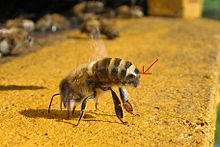
Nasonov's gland produces a pheromone used in recruitment in worker honeybees. The pheromone can serve the purposes of attracting workers to a settled swarm and draw bees who have lost their way back to the hive. It is used to recruit workers to food that lacks a characteristic scent and lead bees to water sources. The gland is located on the dorsal side of the abdomen. Its opening is located at the base of the last tergite at the tip of the abdomen.
The gland was first described in 1882 by the Russian zoologist Nikolai Viktorovich Nasonov (February 14, 1855 – February 11, 1939). Nasonov thought that the gland performed perspiration; it was Frederick William Lambert Sladen (May 30, 1876 - 1921) of England who in 1901 first proposed that the gland produced a pheromone.
See also
References
- Насонов, Н. В. (1885) "О строеніи кожныхъ железъ пчелъ" Известия Императорского Общества Любителей Естествознания, Антропологии и Этнографии: Зоологический Сад и Акклиматизация, Том второй. Годичное Заседание Отделения Беспозвоночных Животных Императорскаго Русскаго Общества Акклиматизации Животных и Растений 27 Июля 1882. 46:2-3. (in Russian)
- naturebee (February 13, 2016). "The biography of Nikolai Viktorovich Nasonov". Beesource. Retrieved 30 May 2021.
- Nasonov's findings were reported to the West in 1883 by A. Zoubareff (also spelled: Zoubarev):
- Zoubareff, A. (November 1883). "A propos d'un organ de l'abeille non encore d'ecrit" [Regarding an organ of bees that has not yet been described]. Bulletin d'Apiculture pour la Suisse Romande (in French). 5 (11): 215–216.
- Republished in English: Zoubareff, A.; Benton, Frank, trans. (15 December 1883). "Concerning an organ of the bee not yet described". The British Bee Journal. 11: 296–297.
{{cite journal}}: CS1 maint: multiple names: authors list (link)
- Snodgrass, Robert E. (1925). Anatomy and Physiology of the Honeybee. New York City, New York, USA: McGraw-Hill. pp. 114-117 (and references on pp. 307-313).
- (Snodgrass, 1925), p. 114.
- See:
- (Snodgrass, 1925), p. 116.
- Sladen, F. W. L. (11 April 1901). "A scent organ in the bee". The British Bee Journal. 29: 142–143, 151–153.
- Republished in condensed form in: Sladen, F.W.L. (1 August 1901). "A scent-producing organ in the abdomen of the bee". Gleanings in Bee Culture. 19: 339–340.
- Reprinted in: Sladen, F.W.L. (September 1902). "A scent-producing organ in the abdomen of the worker of Apis mellifera". The Entomologist's Monthly Magazine. 38: 208–211.
- Allaby, Michael. The Concise Oxford Dictionary of Zoology. 305. Oxford University Press. New York. 1992.
- Greenfield, Michael D. Signalers and receivers : mechanisms and evolution of arthropod communication. 107. Oxford University Press. 2002. Online. June 9, 2008. Google books. ISBN 0-19-513452-4
- Meyer, John R. Social Bees. Department of Entomology NC State University. January 31, 2006. Online. June 9, 2008.
This insect anatomy–related article is a stub. You can help Misplaced Pages by expanding it. |